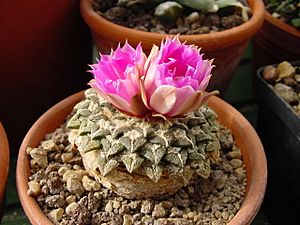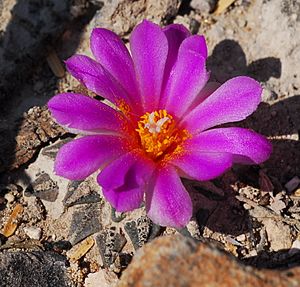Ariocarpus kotschoubeyanus facts for kids
Quick facts for kids Ariocarpus kotschoubeyanus |
|
|---|---|
 |
|
| Conservation status | |
| Scientific classification |
Ariocarpus kotschoubeyanus is a very special type of plant that belongs to the Cactaceae family, which means it's a cactus! It's often called a "living rock" cactus because it blends in so well with its surroundings. This unique plant is quite rare and can only be found in certain parts of Mexico.
Contents
Meet the Living Rock Cactus!
This amazing cactus, Ariocarpus kotschoubeyanus, is known for its unusual look. Unlike many tall, spiky cacti, this one grows very low to the ground. It has a flat, star-shaped body with small, bumpy sections that help it look like a rock. This helps it hide from animals and survive in harsh desert conditions.
Where Does It Live?
This particular cactus is endemic to Mexico. This means it naturally grows only in a specific area and nowhere else in the world! You can find it in the northeastern states of Coahuila and Nuevo León. It also grows further south into the state of Querétaro.
Its natural habitat is in hot, dry deserts. It loves rocky, flat areas where it can hide among stones. The soil in these places is usually made of limestone.
A Cactus with a Noble Name
The name kotschoubeyanus comes from a noble family called the Kochubey family. They were an important family from Ukraine. Many plants and animals are named after people who discovered them or people who supported scientific work.
Why Is It Special?
Even though it looks like a rock, this cactus produces beautiful flowers. These flowers can be pink, purple, or magenta. They usually bloom in the fall, adding a splash of color to the desert landscape.
Facing Challenges
Sadly, Ariocarpus kotschoubeyanus is a threatened species. This means its numbers are decreasing, and it could be in danger of disappearing forever if we don't protect it.
The biggest problem it faces is habitat loss. This happens when the places where it naturally grows are destroyed or changed. For example, land might be cleared for farming, building, or mining. People also sometimes illegally collect these cacti from the wild, which further harms their populations.
- The International Union for Conservation of Nature (IUCN) lists it as "Near Threatened" (NT). This means it's close to being considered vulnerable.
- It is also listed under CITES Appendix I (CITES_A1). CITES stands for the Convention on International Trade in Endangered Species of Wild Fauna and Flora. Appendix I means that international trade of this plant is strictly controlled and mostly forbidden. This is to protect it from being taken from its natural home.
Protecting these unique cacti and their desert homes is important. This helps keep our planet's amazing plant diversity safe for future generations.
See also
 In Spanish: Pezuña de venado para niños
In Spanish: Pezuña de venado para niños



